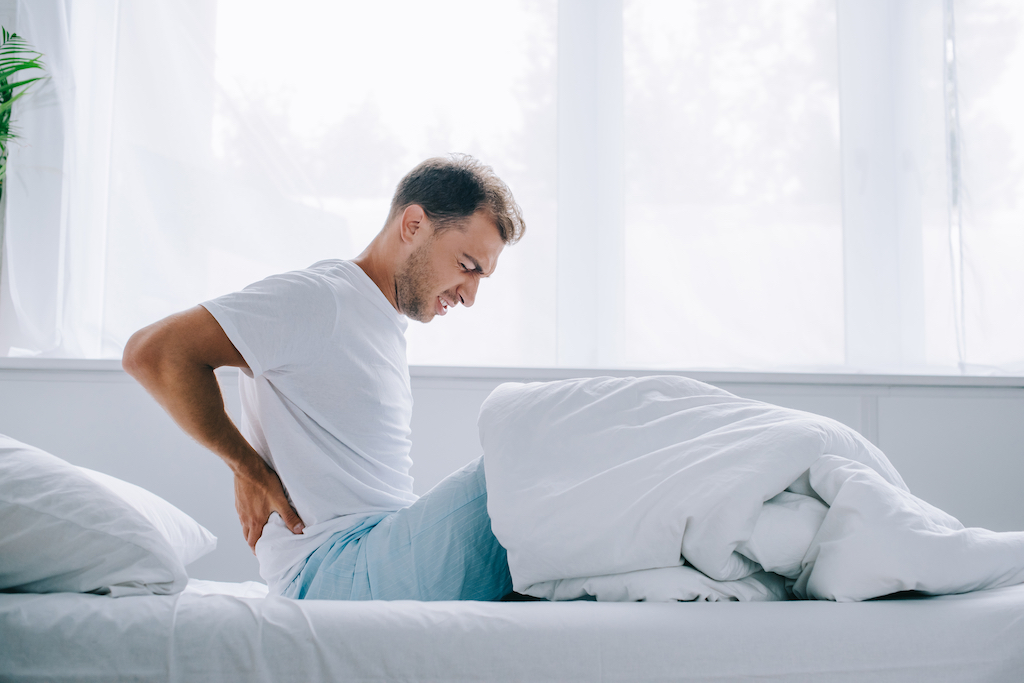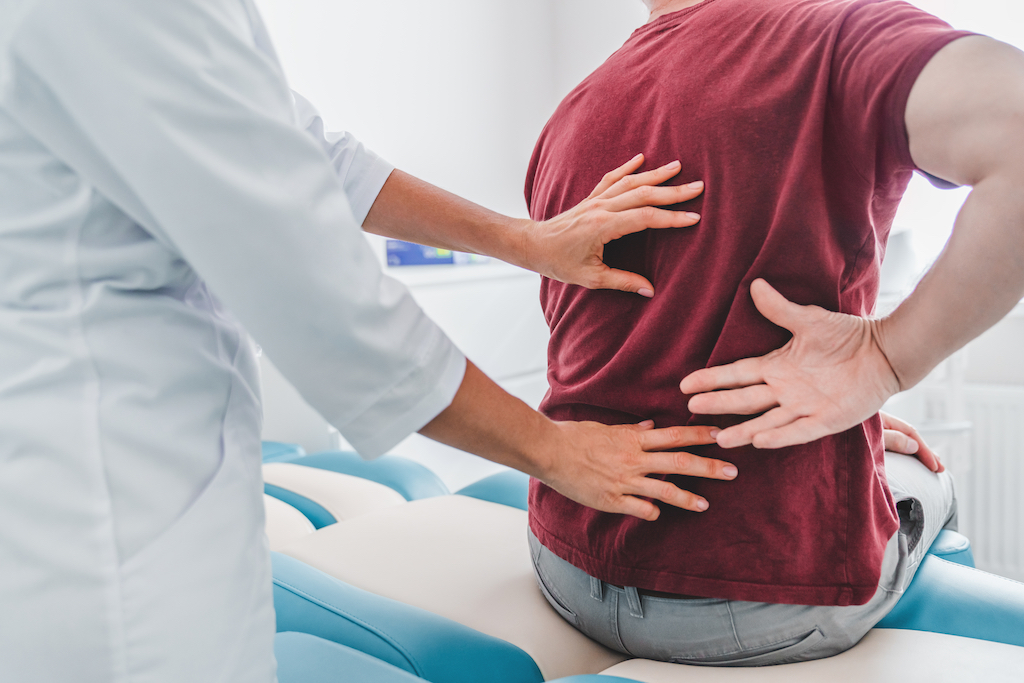Dr. Akash Mehta is an Emergency Medicine board-certified specialist, health and fitness consultant, and Concierge Medicine physician based out of Los Angeles. After finishing medical school at the Touro College of Medicine in Manhattan, Dr. Mehta completed his Emergency Medicine residency at Mount Sinai Medical Center in Miami Beach. Then Dr. Mehta joined Kaiser Permanente as an Emergency Medicine attending physician in West Los Angeles. After years of obtaining intricate knowledge of the healthcare system, he decided to branch on his own and create Nyla Health. He continues to work with various Emergency Medicine groups in and around Los Angeles, and most notably had extensive experience in the frontline during the COVID-19 pandemic.
 Photo Credit: Shutterstock
Photo Credit: Shutterstock
"What the--," you just muttered to yourself as you turned to shut off your phone alarm. You just felt a sharp pain in your lower back as you had reached over to your phone. And now you're feeling it again as you're trying to get yourself up for work! You carefully turn your body to the side and try to have your legs on the floor as you get yourself up to reduce the pain. You've had some back pains here and there before, but not like this. It seems to be fine when lying flat, but you feel its wrath when you walk to the bathroom! You used to deadlift heavy before without a problem—for high school football. And with the pandemic, you haven't exercised much in the last couple of years. Now you recall feeling a bit of pain when you picked up your nephew yesterday.
If any of this sounds familiar, fortunately, you are not alone. Here Haute MD expert Dr. Akash Mehta reviews back pain and its commonality. As a matter of fact, it's estimated that 60-70% of people in industrialized countries suffer from non-specific low back pain at some point in their lives. This prevalence peaks between the ages of 35 and 55.
What is the leading cause of back pain?
Lower back pain is the number one reason for activity limitation and work absence throughout much of the world. In the United States, it is the sixth most costly medical condition concerning our national healthcare costs.
The leading cause of back pain is a sprain or strain; as discussed in Treat Your Strains and Sprains Before you Train. To recap briefly, a sprain and strain refer to stretched or torn ligaments, tendons, and muscles, all of which surround your spinal bones as they do bones in other parts of your body. Another widespread cause would be exacerbating or worsening a herniated disc. Cushions of tissue called discs separate the spinal bones.
These discs move out of place after repetitive poor posture, lifting incorrectly, weight on the spine from daily activities, and weakening discs as we age. They can be displaced enough to impinge on the surrounding nerves and lead to referred numbness/pain in your legs or worse.
Age also brings two very common causes of back pain known as arthritis and osteoporosis. More than 52 million adults suffer from arthritis in the United States; it is a chronic inflammation of joints that can also affect the joints of your back. Osteoporosis is four times as common in women as it is in men, and it is a disease that causes bones to weaken. This can lead to painful fractures in your spinal bones from simple movements such as sitting down or bending over.
How do you treat "bone-and-muscle related" causes of back pain?
Such "bone-and-muscle related" (musculoskeletal) causes of back pain far away from the most common causes of non-specific back pain. Fortunately, they are rarely dangerous and can be treated initially with rest, ice (and later heat), and over-the-counter pain medicine. Provide rest for your injury for at least a couple of days but may need more, depending on the cause. Ice the injury 20 minutes for every hour that you are awake. In 2-3 days, it may be more beneficial to switch to heat.
Anti-inflammatory medicine such as ibuprofen and naproxen are usually better for analgesia concerning back pain because it provides anti-inflammatory properties that acetaminophen (with the most famous brand being Tylenol) does not. However, such anti-inflammatory medicines have many more interactions with other medicines, especially "blood-thinning" medicines; they also affect the kidneys. Please discuss with your primary care or specialist medical professional before starting any over-the-counter medicine or herbal supplements.
Are simple treatments a cure?
Such simple treatment will only be a temporary "fix" for more complex musculoskeletal causes of your back pain. As you may have inferred, rest and ice will not cure a herniated disc, arthritis, osteoporosis, etc.
If you have not seen any improvement or are having severe, recurring symptoms for one week or more, you likely will have to see your primary care doctor for an evaluation. They may need to obtain in-depth imaging such as an MRI for further analysis, and you may need referrals for physical therapy and pain management physicians/spinal surgeons. Diseases such as osteoporosis and cancer will require other medicines and modalities to treat these underlying diseases. (Don't worry; the prevalence of cancer being a cause of non-traumatic back pain is estimated to be less than 3.5%).
If you are developing severe numbness in both legs, weakness of both legs, urinary retention, bowel or bladder incontinence, please immediately visit your nearest emergency department (ED). These could be signs of moderate to severe impingement of your spinal cord from various issues such as a severely herniated disc, arthritis, a tumor, a fracture, and others which could lead to paralysis if not quickly discovered and treated.
 Photo Credit: Shutterstock
Photo Credit: Shutterstock
Should you be aware of any dangerous causes of back pain?
There are a couple of notable but rare but dangerous non-musculoskeletal causes of back pain. The first one of note would be concerning the aorta. The aorta is the largest artery in our body, and it traverses just adjacent to your spinal bones. Thus naturally, abnormalities of the aorta can cause back pain, along with chest and abdominal pain. Rarely can the aorta tear without trauma, or it can develop an aneurysm (bulging of the walls to create a "balloon") over time which can leak. Both develop primarily in males, and the main risk factors include the common heart disease risk factors such as smoking, high blood pressure, high cholesterol, diabetes and family history. However, the former can also be caused in a younger population due to connective tissue disease and pregnancy.
The main symptom of these conditions can be sudden onset, atraumatic back pain (often accompanied by chest pain and/or abdominal pain). It may be accompanied by numbness, tingling, focal weakness, and/or stroke-like symptoms (since your brain may not be getting enough blood and oxygen). Please call your local Emergency Medical Services (EMS), such as through dialing 9-1-1 in the United States if you have symptoms such as these.
The other notable non-musculoskeletal urgency causing back pain would be a spinal infection. This could be an epidural abscess (a collection of infection between your spinal bones and spinal cord), vertebral osteomyelitis (infection of a spinal bone), or discitis (infection of the discs in between the spinal bones mentioned earlier). This is also rare because it usually occurs in those whose immunity is compromised and/or those who have had had recent or frequent "history with their veins or spinal bones."
More specifically, this population includes those with cancer, intravenous drug use, alcoholism, kidney failure, diabetes, a current distant site of infection, or a recent spinal procedure. The classic teaching considers these diagnoses in those with a fever and localized back pain to the spinal bones. However, these are complex diagnoses for even the astute medical professional because fever is present in only ~50% of cases and usually requires an MRI (not easily available in a rapid situation) to diagnose. Often, this is diagnosed after an immunocompromised patient has non-resolving back pain after a couple of evaluations and other causes have been ruled out. In general, it's suggested to go to the nearest ED for any new fever with nontraumatic back pain, especially when there is no other reason for the fever, such as "flu-like" symptoms.
How can you prevent pulling your back out?
However, sprains/strains and herniated discs are your usual culprit for "pulling your back" and can be prevented. First and foremost, use proper lifting techniques; don't bend at the waist. Keep your back straight and bend at the knees. Additionally, maintain a healthy weight; excess weight puts pressure on the lower back. Next, improve your posture—good posture reduces strain on the spine. When you exercise, stretching is extremely important. Workouts that strengthen the "core" muscles (abdomen and lower back muscles) are key; strong and flexible core muscles take away stress on the spine.
All in all, back pain is one of the most common medical complaints for EDs and general practitioners worldwide, with musculoskeletal reasons such as sprains/strains and herniated discs being the most common causes. Unfortunately, they become more prevalent as we age due to weakening muscles around the spine and the discs between the spinal bones. As mentioned, they can be treated with home remedies that include rest, ice/heat, and over-the-counter analgesics. Further modalities such as physical therapy, "spinal injections" with certain medications, and others can be discussed with your primary care doctor or referred specialists. Again, prevention is key. Incorporate proper lifting techniques, posture, weight maintenance, exercise and stretching.
Red flags that may indicate more severe or dangerous medical conditions include:
- Sudden severe back pain without trauma
- Weakness of both legs
- Inability to control your bowel or bladder urinary retention
- Stroke-like symptoms
- Accompanying abdominal and/or chest pain
- Fever/chills
If you develop any of these, please call your local EMS to get to your nearest ED.
Spring is here, so get out there and be active! And please bend your knees and not your back when you're lifting those boxes for spring cleaning and the yard sale—your back will thank you later.























